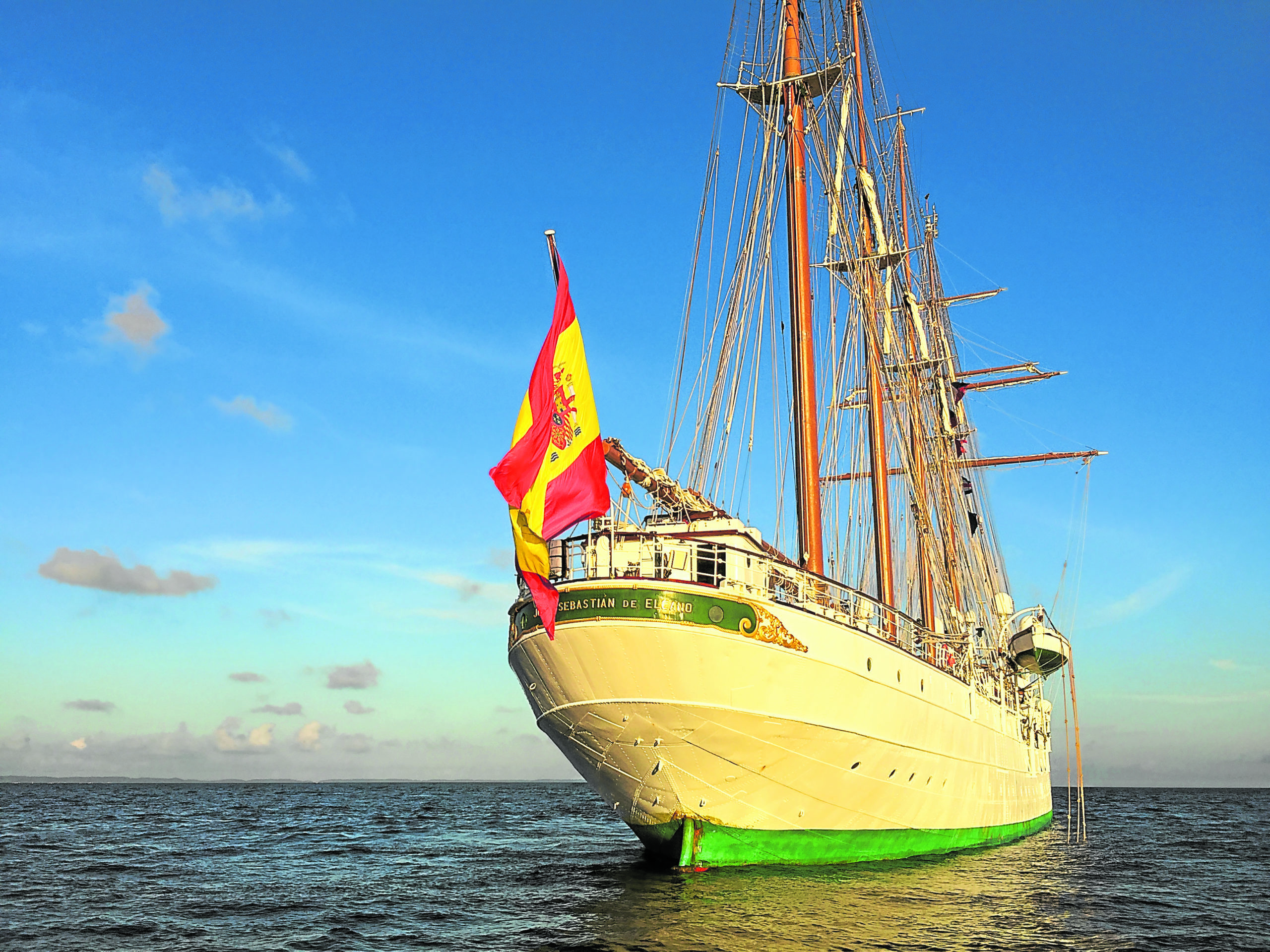
The Spanish training ship Juan Sebastián de Elcano, anchored off Suluan Island in Guiuan, Eastern Samar, was a welcome sight for those on board a big motorized banca—dignitaries from the Spanish Embassy in Manila, officers of the National Historical Commission of the Philippines (NHCP), local government officials and historians—after about two long hours of travel en route from Guiuan town proper to the island. It is also where the weary crew of the Magellan-Elcano expedition first landed after skirting the rocky shores of the southernmost tip of Samar Island exactly 500 years ago on March 16, 1521.
The one-way trip on a calm sea took three hours, but everyone’s anxiousness was relieved with the sight of the pristine island, rocky outcrops and beautiful white-sand beaches.
It is in Suluan that the Spanish expedition first sighted the inhabitants of the island, but the first physical contact between them happened two days after in the nearby, then uninhabited and sacred island of Homonhon, where the Europeans were treated well and given provisions.
Both islands, together with Calicoan Island (also in Guiuan), were recently recognized by the NHCP through the National Quincentennial Committee (NQC) due to their significance in the first circumnavigation of the world, being the first among the islands later to be called the Philippines to figure in the event of international importance that happened 500 years ago
Compassionate
Speaking at the Suluan event, NHCP Chair Rene Escalante underscored the importance of the occasion.
“The year 1521 in Philippine history is just a window for us to appreciate the world of our ancestors, and to be excited about what lies beyond the precolonial Philippines,” he said.
“Nothing to be disowned but to own, nothing to be ashamed of but to take pride in, nothing to antagonize but to synergize,” he added.
Escalante, who is also the executive director of the NQC, said that “the quincentennial reminds us all, Filipinos, that we are triumphant and compassionate people, just like our ancestors recorded in 1521.”
Suluan village chair Edgar Loyola expressed his island-barangay’s gratitude, for they are “fortunate to witness the tribute to Suluan.”
“Your presence here with us not only brings joy and honor, but it also validates what has been taught to us through generations, that kindness is a powerful language that goes a long way,” he said.
“It creates a ripple that lasts many lifetimes,” he added.
Humanity
In his speech at the Homonhon marker unveiling, Spain Ambassador Jorge Moragas Sanchez emphasized that what happened on the island on March 17, 1521, was an act of kindness, the “main principle that we need to remember.”
It was on that day that the residents of Suluan had contact with the weary men of the Spanish expedition led by Ferdinand Magellan, who requested for food and something to eat from the locals, which the latter provided the following day.
“That day (March 17) was the first human touch, human contact in that fact, in that time, it was the real arrival that took place on this island,” Sanchez said.
“This coincidence in time and space is the thing that we have to remember,” he said, adding that “contact is based on the idea of friendship, humanity and solidarity, especially on the Filipino side.”
Sanchez said what was commemorated in Homonhon, the kindness of the Suluan residents to strangers, is the lasting legacy of that coincidental meeting.
“What happened there is the core of what we are commemorating today, humanity,” he said.
Juan Sebastián Elcano
Apart from the marker unveilings and a lecture on Magellan and the Philippines by historian and Inquirer columnist Ambeth Ocampo, the Spanish training ship Juan Sebastián de Elcano, which is retracing the Magellan-Elcano expedition of 1519 to 1522, anchored off Suluan, Manicani and Homonhon Islands from March 16 to March 18.
On March 16, a flotilla of boats from the Guiuan mainland welcomed the ship anchored off Manicani Island, a surreal experience, according to historian and municipal administrator Kinna Mae Kwan.
The day prior, the Guiuan Museum design was unveiled and the Guiuan Quincentennial Exhibit opened at the municipal hall compound.
The exhibit was curated inside four reused container vans, which served as the town’s municipal hall following the onslaught of Supertyphoon “Yolanda” (international name: Haiyan) in 2013.
It features the colorful history of Guiuan from the precolonial settlement in Suluan to the Spanish and American periods, the story of the White Russian refugees from 1949 to 1951 and the disastrous 2013 supertyphoon.
A historical marker for the restored Guiuan Church was also unveiled on March 18.The church, a National Cultural Treasure, was destroyed by Yolanda in 2013, and was restored by the National Museum from 2016 to 2019.
The church grounds also served as the venue of the closing ceremonies on March 18, highlighted by an impressive cultural show featuring local talents, including soprano Gerphil Flores.
The five-day event, the opening salvo of the National Quincentennial Commemorations with the theme “Victory and Humanity” was a success, a celebration of Guiuan’s humanity and generosity, according to Mayor Annaliza Gonzales-Kwan.
“While our folks and your folks both ran away from each other at first, we—their descendants—are both here in this beautiful little town together,” she said during the opening of the exhibit.
“We remember and celebrate how they both overcame their initial doubt and eventually gave and found respect, even friendship,” she added.
—CONTRIBUTED
Author’s note: Not far from the Homonhon quincentennial marker are two rocks inscribed with Ferdinand Magellan’s Portuguese name, Fernão de Magalhães, and the initials of his son’s name, Cristobal Ravelo. Historian Rolando Borrinaga, with his son George, also a historian, said these inscriptions date back to 1521, and the one bearing the name of Magellan was possibly inscribed by Magellan himself. Both stones have been either defaced or vandalized.













































